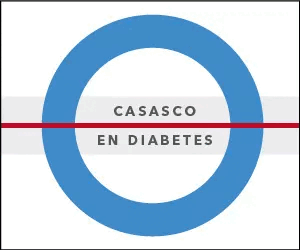Update of bariatric and metabolic surgery
DOI:
https://doi.org/10.47196/diab.v47i3.211Keywords:
type 2 diabetes, morbid obesity, bariatric surgery, metabolic surgeryAbstract
Obesity increases the risk of developing or worsening many disorders particularly type 2 diabetes, a difficult-to-control chronic disease, treated with different drugs even with insulin, frequently without reaching therapeutic goals neither reducing cardiovascular risk. Therapy becomes more complex when type 2 diabetes is associated with severe obesity. The use of bariatric and metabolic surgery in patients with severe obesity and diabetes is assessed, and the different surgical techniques, assumptions about its mechanism of action, selection of patients and results are also reviewed. Bariatric surgery has proven to be effective in the treatment of severe obesity and type 2 diabetes in patients with BMI >35 kg/m2. This type of surgery has shown to be acceptable and well tolerated in selected and low risk patients capable of treatment Bariatric surgery has sufficient scientific evidence in these patients. However, there is no strong evidence of metabolic surgery in patients with BMI <35 kg/m2 and even with BMI <30 kg/m2. Preliminary data shows promising results in the short and intermediate term, but there is no sufficient evidence available supporting its indication in these patients. More research is needed to establish the efficacy and safety of these surgical techniques in the long term.
References
www.who.int/mediacentre/factsheets/fs311. Última revisión 1/6/2013.
Zimmet P, Shaw J and Albert KG. Preventing Type 2 diabetes and the dysmetabolic syndrome in the real world: a realistic view. Diabet Med. 2003; 20:693-702.
Khan MA, St Peter JV, Breen GA, Hartley GG, Vessey JT. Diabetes disease stage predicts weight loss outcomes with long-term appetite suppressants. Obes Res. 2000; 8:43-48.
Zimmet P, Shaw J, Alberti KG. Preventing type 2 diabetes and the dysmetabolic syndrome in the real world: a realistic view. Diabet Med. 2003; 20:693-702.
Pan X, Li G, Hu Y, Wang J, Yang W, An Z Hu ZX, Lin J, Xiao JZ, Cao HB, Liu PA, Jiang XG, Jiang YY, Wang JP, Zheng H, Zhang H, Bennett PH, Howard BV. Effects of diet and exercise in preventing NIDDM in people with impaired glucose tolerance: the DaQing IGT Diabetes Study. Diabetes Care 1997; 20: 537-544.
Tuomilehto J, Lindstrom J, Eriksson J, Valle T, Hamalainen H, Ilanne-Parikka P Keinänen-Kiukaanniemi S, Laakso M, Louheranta A, Rastas M, Salminen V, Uusitupa M; Finnish Diabetes Prevention Study Group. Prevention of type 2 diabetes mellitus by changes in lifestyle among subjects with impaired glucose tolerance. N Engl J Med 2001; 344: 1343-1350.
Knowler WC, Barrett-Connor E, Fowler SE, Hamman RF, Lachin JM, Walker EA Nathan DM; Diabetes Prevention Program Research Group. Reduction in the incidence of type 2 diabetes with lifestyle intervention or metformin. N Engl J Med 2002; 346: 393-403.
Look AHEAD Research Group. Reduction in Weight and Cardiovascular Disease Risk Factors in Individuals With Type 2 Diabetes: One-Year Results of the Look AHEAD Trial. Diabetes Care. 2007; 30:1374-1383.
Dixon JB, O'Brien PE, Playfair J, Chapman L, Schachter LM, Skinner S, Proietto J, Bailey M, Anderson M. Adjustable gastric banding and conventional therapy for type 2 diabetes: a randomized controlled trial. JAMA. 2008;299:316-623.
Sjöström L, Review of the key results from the Swedish Obese Subjects (SOS) trial- a prospective controlled intervention study of bariatric surgery. J Intern Med 2013; 273: 219–234.
World Health Organizacion. BMI Classification. http://apps.who.int/bmi/index.jsp?introPage=intro_3.html
Mason EE, Ito C. Gastric bypass in obesity. Surg Clin North Am. 1967; 47:1345-1351
Rubino F, Schauer PR, Kaplan LM, Cummings DE. Metabolic Surgery to Treat Type 2 Diabetes: Clinical Outcomes and Mechanisms of Action. Annu. Rev. Med. 2010. 61:393-411.
Buse JB, Caprio S, Cefalu WT, Ceriello A, Del Prato S, Inzucchi SE, McLaughlin S, Phillips GL 2nd, Robertson RP, Rubino F, Kahn R, Kirkman MS. How do we define cure of diabetes? Diabetes Care. 2009; 32:2133-2135.
Clinical Guidelines on the Identification, Evaluation, and Treatment of Overweight and Obesity in Adults: The Evidence Report http://www.nhlbi.nih.gov/guidelines/obesity/ob_gdlns.htm
Rubio MA, Martínez C, Vidal O, Larrad A, Salas-Salvado J, Pujol J, Díez I. Moreno B. Documento de consenso sobre cirugía bariátrica. Rev Esp Obes. 2004; 4: 223 249.
Runkel N. Evidence-based german guidelines for surgery for obesity. Int J Colorectal Dis. 2011; 26:397-404.
Rubino F, Kaplan LM, Schauer PR, Cummings DE. The Diabetes Surgery Summit Consensus Conference: recommendations for the evaluation and use of gastrointestinal surgery to treat type 2 diabetes mellitus. Ann Surg. 2010; 251: 399-405.
Vetter ML, Cardillo S, Rickels MR, Iqbal N. Narrative Review: Effect of Bariatric Surgery on Type 2 Diabetes Mellitus. Ann Intern Med. 2009; 150:94-103.
Dixon JB, le Roux CW, Rubino F, Zimmet P. Bariatric surgery for type 2 diabetes. Lancet. 2012; 379:2300–2311.
Soni A, Shukla AP, Rubino F. Interventional Diabetology: The Evolution of Diabetes Care in the XXI Century. Curr Atheroscler Rep. 2012; 14:631-636.
Schauer PR, Burguera B, Ikramuddin S, Cottam D, Gourash W, Hamad G, Eid GM, Mattar S, Ramanathan R, Barinas-Mitchel E, Rao RH, Kuller L, Kelley D. Effect of laparoscopic Roux-en Y gastric bypass on type 2 diabetes mellitus. Annals of Surg. 2003; 238:467-484.
Sareli AE, Cantor CR, Williams NN, Korus G, Raper SE, Pien G, Hurley S, Maislin G, Schwab RJ. Obstructive Sleep Apnea in Patients Undergoing Bariatric Surgery. A Tertiary Center Experience. Obes Surg. 2011;21:316–327
Jamal M, Wegner R, Heitshusen D, Liao J, Samuel I. Resolution of hyperlipidemia follows surgical weight loss in patients undergoing Roux-en-Y gastric bypass surgery: a 6-year analysis of data. Surgery for Obesity and Related Diseases. 2011; 473-479.
Nguyen T, Lau DC. The Obesity Epidemic and Its Impact on Hypertension. Canadian Journal of Cardiology. 201228:326–333.
Vincent HK, Ben-David K, Cendan J, Vincent KR, Lamb KM, Stevenson A. Effects of bariatric surgery on joint pain: a review of emerging evidence. Surg Obes Relat Dis. 2010; 6:451-460.
Romeo S, Maglio C, Burza MA, Pirazzi C, Sjöholm K, Jacobson P, Svensson PA, Peltonen M, Sjöström L, Carlsson LM. Cardiovascular Events After Bariatric Surgery in Obese Subjects With Type 2 Diabetes. Diabetes Care. 2012; 35:2613-2617.
Sjöström L, Peltonen M, Jacobson P, Sjöström CD, Karason K, Wedel H, Ahlin S, Anveden Å, Bengtsson C, Bergmark G, Bouchard C, Carlsson B, Dahlgren S, Karlsson J, Lindroos AK, Lönroth H, Narbro K, Näslund I, Olbers T, Svensson PA, Carlsson LM. Bariatric Surgery and Long-term Cardiovascular Events JAMA. 2012; 307:56-65.
Sjöström L, Narbro K, Sjöström CD, Karason K, Larsson B, Wedel H, Lystig T, Sullivan M, Bouchard C, Carlsson B, Bengtsson C, Dahlgren S, Gummesson A, Jacobson P, Karlsson J, Lindroos AK, Lönroth H, Näslund I, Olbers T, Stenlöf K, Torgerson J, Agren G, Carlsson LM; Swedish Obese Subjects Study. Effects of Bariatric Surgery on Mortality in Swedish Obese Subjects, N Engl J Med. 2007; 357:741-752.
Sjöström L, Gummesson A, Sjöström CD, Narbro K, Peltonen M, Wedel H, Bengtsson C, Bouchard C, Carlsson B, Dahlgren S, Jacobson P, Karason K, Karlsson J, Larsson B, Lindroos AK, Lönroth H, Näslund I, Olbers T, Stenlöf K, Torgerson J, Carlsson LM; Swedish Obese Subjects Study. Effects of bariatric surgery on cancer incidence in obese patients Lancet Oncol. 2009; 10:653–662.
Sjöström L, Lindroos AK, Peltonen M, Torgerson J, Bouchard C, Carlsson B, Dahlgren S, Larsson B, Narbro K, Sjöström CD, Sullivan M, Wedel H; Swedish Obese Subjects Study Scientific Group. Lifestyle, diabetes, and cardiovascular risk factors 10 years after bariatric surgery. N Engl J Med. 2004; 351:2683-2693.
Jones KB, Jr. Experience withth eRoux-en-Y gastric bypass, and commentary on current trends. Obes Surg. 2000; 10:183-185.
Cummings DE, Overduin J, Foster-Schubert KE. Gastric bypass for obesity: Mechanisms of weight loss and diabetes resolution. J Clin Endocrinol Metab. 2004; 89:2608-2615.
Schauer PR, Burguera B, Ikramuddin S, Cottam D, Gourash W, Hamad G, Eid GM, Mattar S, Ramanathan R, Barinas-Mitchel E, Rao RH, Kuller L, Kelley D. Effect of laparoscopic Roux-en Y gastric bypass on type 2 diabetes mellitus. Ann Surg. 2003; 238:467.
Sugerman HJ, Wolfe LG, Sica DA, Clore JN. Diabetes and hypertension in severe obesity and effects of gastric bypass-induced weight loss. Ann Surg. 2003; 237:751.
Buchwald H, Avidor Y, Braunwald E, Jensen MD, Pories W, Fahrbach K, Schoelles K. Bariatric surgery: A systematic review and meta-analysis. JAMA. 2004;292:1724.
Dixon JB, Dixon AF, O’Brien PE. Improvements in insulin sensitivity and cell function (HOMA) with weight loss in the severely obese. Homeostatic model assessment. Diabet Med. 2003; 20:127-134.
Sala PC, Torrinhas RS, Heymsfield SB, Waitzberg DL. Type 2 Diabetes Mellitus: A Possible Surgically Reversible Intestinal Dysfunction. Obes Surg. 2012; 22:167-176.
Yamaoka K, Tango T. Efficacy of lifestyle education to prevent type 2 diabetes: a meta-analysis of randomized controlled trials. Diabetes Care. 2005; 28:2780-2786.
Sjöström L, Review of the key results from the Swedish Obese Subjects (SOS) trial. A prospective controlled intervention study of bariatric surgery. J Intern Med 2013; 273: 219–234.
Carlsson LM, Peltonen M, Ahlin S, Anveden Å, Bouchard C, Carlsson B, Jacobson P, Lönroth H, Maglio C, Näslund I, Pirazzi C, Romeo S, Sjöholm K, Sjöström E, Wedel H, Svensson PA, Sjöström L.. Bariatric surgery and prevention of type 2 diabetes in Swedish Obese Subjects. N Engl J Med, 2012; 367: 695–704.
Bariatric Surgical and Procedural Interventions in the Treatment of Obese Patients with Type 2 Diabetes A position statement from the IDF Taskforce on Epidemiology and Prevention 2011. En http://www.idf.org/webdata/docs/IDF-Position-Statement-Bariatric-Surgery. Ultimo ingreso: mayo 2013.
Dixon JB, le Roux CW, Rubino F, Zimmet P. Bariatric surgery for type 2 diabetes. Lancet. 2012; 379: 2300-2311.
Pories WJ, Dohm LG, Mansfield CJ. Beyond the BMI: the search for better guidelines for bariatric surgery. Obesity. 2010; 18:865–871.
Sjöström L. Review of the key results from the Swedish Obese Subjects (SOS) trial. A prospective controlled intervention study of bariatric surgery. J Intern Med 2013; 273:219–234.
Livingston E. Inadequacy of BMI as an Indicator for Bariatric Surgery. JAMA, 2012; 307:99,89.
Buchwald H Consensus Conference Panel. Consensus Conference Statement Bariatric surgery for morbid obesity: Health implications for patients, health professionals, and third-party payers Surgery for Obesity and Related Diseases. 2005; 1:371-381.
Dixon JB, Zimmet P, Alberti KG, Rubino F. Bariatric surgery: an IDF statement for obese type 2 diabetes. Diabet Med 2011; 28: 628-642.
Zimmet P, Alberti KGMM, Rubino F, Dixon JB. IDF’s view of bariatric surgery in type 2 diabetes. Lancet 2011; 378: 108-110.
Lautz D,Halperin F, Goebel-Fabbri A,Goldfine A. The great debate: medicine or surgery: what is best for the patient with type 2 diabetes? Diabetes Care. 2013; 13:16-24.
Arterburn DE, Bogart A, Sherwood NE, Sidney S, Coleman KJ, Haneuse S, O'Connor PJ, Theis MK, Campos GM, McCulloch D, Selby J. Multisite study of long -term remission and relapse of type 2 diabetes mellitus following gastric bypass. Obes Surg. 2013; 23:93-102.
Laferrère B, Swerdlow N, Bawa B, Arias S, Bose M, Oliván B, Teixeira J, McGinty J, Rother KI. Rise of oxintomodulin in response to oral glucose after gastric bypass surgery in patiens with type 2 diabetes. J Clin Endocrinol Metab. 2010; 95:4072-4076.
Strader AD, Vahl TP, Jandacek RJ, Woods SC, D'Alessio DA, Seeley RJ. Weight loss through ileal transposición is accompanied by increased ileal hormone secretion and synthesis in rats. Am J Psysiol Endocrinol Metab. 2005; 288:E447-E453.
Rubino F, Marescaux J. Effect of duodenal-yeyunal exclusión in a non-obese animal model of type 2 diabetes: a new perspective for an old diseases. Ann Surgery. 2004; 239:1-11.
Rubino F, Forgione A, Cummings DE, Vix M, Gnuli D, Mingrone G, Castagneto M, Marescaux J. The mechanism of diabetes control after gastrointestinal bypass surgery reveals a role of the proximal small intestine in the pathophysiology of type 2 diabetes. Ann Surg. 2006; 244:741-749.
Kirchner H, Gutierrez JA, Solenberg PJ, Pfluger PT, Czyzyk TA, Willency JA, Schürmann A, Joost HG, Jandacek RJ, Hale JE, Heiman ML, Tschöp MH. GOAT links dietary lipids with the endocrine control of energy balance. Nat Med. 2009;15:741-745.
Li Z, Zhang HY, Lv LX, Li DF, Dai JX, Sha O, Li WQ, Bai Y, Yuan L. Roux-en-Y gastric bypass promotes expression of PDX-1 and regeneration of beta-cell in Goto-Kakizaki rats. World J Gastroenterol 2010; 16:2244-2251.
Kohli R, Setchell KD, Kirby M, Myronovych A, Ryan KK, Ibrahim SH, Berger J, Smith K, Toure M, Woods SC, Seeley RJ. A surgical model in male obese rats uncovers protective effects of bile acids post-bariatric surgery. Endocrinology. 2013; 154:2341-2351.
Pournaras DJ, Glicksman C, Vincent RP, Kuganolipava S, Alaghband-Zadeh J, Mahon D, Bekker JH, Ghatei MA, Bloom SR, Walters JR, Welbourn R, le Roux CW. The role of bile after Roux-en-Y gastric bypass in promoting weight loss and improving glycaemic control. Endocrinology. 2012; 153:3613-3619.
van der Ven N. Psychosocial Group Interventions in Diabetes Care. Diabetes Spectrum. 2003; 16:88-95.
Krause N, Herzog AR, Baker E: Providing support to others and well-being in later life. J Gerontol. 1992; 47:300-P311.
Heisler M. Overview of Peer Support Models to Improve Diabetes Self-Management and Clinical Outcomes. Diabetes Spectrum. 2007; 20:214-221.
Gallant MP. The influence of social support on chronic illness self-management: a review and directions for research. Health Educ Behav. 2003; 30:170-195.
Funnell MM The Diabetes Attitudes, Wishes, and Needs (DAWN) Study Clinical Diabetes. 2006; 24:154-155.
Kownacki RJ, Shadish WR: Does Alcoholics Anonymous work? The results from a meta-analysis of controlled experiments. Subst Use Misuse. 1999; 34:1897-1916.
Life After Bariatric Surgery. University of California. San Francisco. http://www.ucsfhealth.org/education/life_after_bariatric_surgery/index.html. Último ingreso 02/06/2013.
Downloads
Published
How to Cite
Issue
Section
License

This work is licensed under a Creative Commons Attribution-NonCommercial-NoDerivatives 4.0 International License.
Dirección Nacional de Derecho de Autor, Exp. N° 5.333.129. Instituto Nacional de la Propiedad Industrial, Marca «Revista de la Sociedad Argentina de Diabetes - Asociación Civil» N° de concesión 2.605.405 y N° de disposición 1.404/13.
La Revista de la SAD está licenciada bajo Licencia Creative Commons Atribución – No Comercial – Sin Obra Derivada 4.0 Internacional.
Por otra parte, la Revista SAD permite que los autores mantengan los derechos de autor sin restricciones.







































